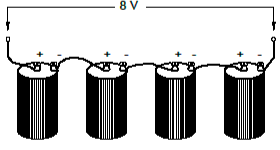If you are wondering what the purpose of battery connections in series, parallel or series-parallel configurations are or what the best arrangement for charging storage, battery bank systems, off-grid systems or solar panel installations is, read on. It all depends on the system requirements, such as increasing the voltages by connecting the batteries in series, increasing the battery ampere hours (because batteries are rated in Ah instead of Amperes) or simply increasing the current or power of the batteries by connecting the batteries in parallel or series-parallel to maintain the system according to your specifications. You can learn how to configure primary (non-rechargeable batteries such as AAA cells) and secondary (rechargeable batteries such as Lead Acid, Nickel Cadmium, Nickel Metal Hydride, Lithium-Ion and other types of batteries) batteries in the following step-by-step guide.
We received some ambiguous circuits on the subject and they inquired as to whether the batteries are connected in series, parallel or series-parallel and which configuration they prefer. Consequently, we will go over the battery connection methods in detail: series, parallel and series-parallel.
Series Connection
It is when you connect two or more batteries together to improve the total voltage of the battery system. Connecting batteries in series does not enhance the capacity of the battery system; it just increases the voltage.
As an example, suppose you link four 12Volt 26Ah batteries together. You will have a battery voltage of 48 Volts and a battery capacity of 26Ah when you purchase this battery. It is necessary for each battery to have the same voltage and capacity rating in order to configure batteries in a series connection; otherwise, you risk damaging the batteries. Using the example above, you can connect two 6Volt 10Ah batteries in series, but you cannot connect a single 6 Volt 10Ah battery with a single 12 Volt 10Ah battery in series.
A series connection of batteries is made by connecting the negative terminal of one battery to the positive terminal of another and so on until all batteries are connected. After connecting a link/cable to the negative terminal of the first battery in your string of batteries to your application, you would connect another cable to the positive terminal of the last battery in your string to your application, then another link/cable to the negative terminal of the first battery in your string to your application and so on until all batteries are connected.
Parallel Connection
It is possible to connect two or more batteries in parallel in order to enhance the amp-hour capacity. While the amp-hour capacity will rise with a parallel battery connection, the voltage of the batteries will remain the same. Consider this: If you link four 12V 100Ah batteries together, you obtain a 12V 400Ah battery system. It is common practice to connect batteries in parallel by connecting the negative terminal of one battery to the negative terminal of the next and so on through the string of batteries. The same is true for connecting positive terminals, with the positive terminal of one battery connected to the positive terminal of the next and so on through the string of batteries. For example, if you needed a 12V 300Ah battery system, you would link three 12V 100Ah batteries together in parallel to achieve the desired result. Parallel battery configuration serves to extend the amount of time that batteries can be used to power equipment; however, because of their greater amp-hour capacity, parallel batteries can take longer to charge than series connected batteries.
Series- Parallel Connection
There are batteries that are connected in series and parallel. When you link a string of batteries in series and parallel, you may enhance both the voltage and the capacity of the battery system. For example, you may link six 6V 100Ah batteries together to form a 24V 200Ah battery by constructing two strings of four batteries in series with one another. Two or more batteries will be connected in series and parallel in order to boost the overall capacity of the system in this configuration. If you require assistance with configuring batteries in series, parallel or series parallel configurations, please do not hesitate to contact one of our battery specialists.
Conclusion
There are three fundamental types of battery connections:
1. Batteries are connected in a series.
If we connect the positive (+) terminal of the battery to the negative (-) terminal and the negative terminal to the positive terminal as indicated in the diagram below, the batteries will be configured in series.

- Battery Connections in a Parallel Configuration
If we connect the positive terminal (+) of the battery to the positive terminal and the negative terminal (-) to the negative terminal, we get the following result. The batteries would then be connected in a parallel manner.

- Batteries are connected in series and parallel in this configuration.
This configuration of batteries would be referred to as a series-parallel connection of batteries if two pairs of two batteries were linked in series and then these series connected batteries were connected in parallel, as in the example above.
In other words, it is neither a series nor a parallel circuit, but is instead referred to as a series-parallel circuit. Some of the components are connected in series, while others are connected in parallel, resulting in a complex circuit of devices and batteries that are connected in series and parallel.
 Profile
Profile Settings
Settings Refer your friends
Refer your friends Sign out
Sign out






